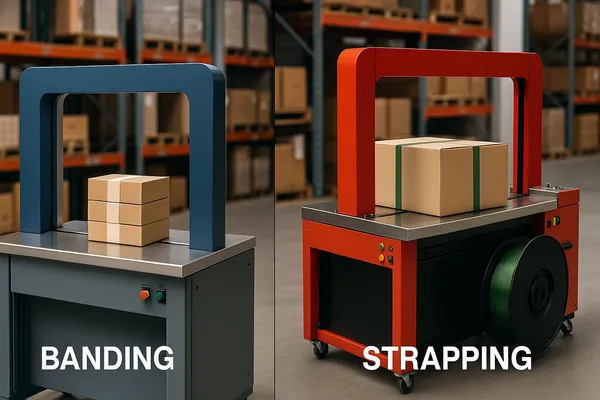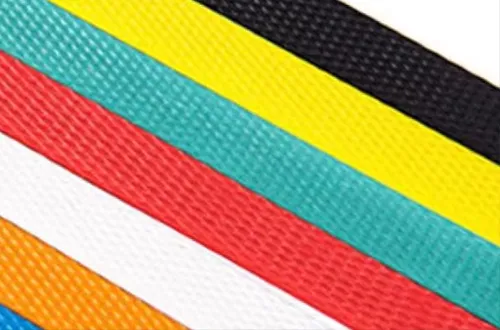Avoid your inquiry is delay response, please enter your WhatsApp/Skype along with the message, so we can contact you at the very first time.
We will reply you within 24 hours. If for urgent case, please add WhatsApp/WeChat: ,. Or call directly.
Damaged boxes, loose loads, and slow lines hurt profits. Confusing choices make it worse. Pick the right strap or banding method, match it to your packaging flow, and automate step by step to cut waste and speed up shipping.
Banding uses a thin paper or film band to bundle and label light items without crushing edges; strapping uses a heavier strap (PP, PET, or steel strap) used to secure boxes, bundles, or a pallet. Choose banding for tidy presentation and gentle hold; use strapping for stronger load restraint and pallet strapping.

When people ask for the difference between strapping and banding, we point to purpose and strapping material. Banding places a slim, gentle band around a small bundle to keep items together and cleanly labeled. Strapping applies a stronger strap around heavier goods that need firm unitizing or to tie a load to a pallet.
In day-to-day packaging, banding works best for printed matter, cosmetics, food sleeves, and delicate cartons where a soft seal and appearance matter. Strapping typically secures cases, timber, bricks, and appliances. You’ll see strapping often in shipping rooms and docks; banding is commonly seen at finishing lines and retail-ready packaging.
“Think presentation vs protection. Band the pretty things; strap the heavy things.”
Ever wonder how a strapping machine work step by step? A strapping machine forms a loop of strap, tensions it around the load, then joins it. Strapping machines use heat sealing (PP), friction welding (PP/PET), or ultrasonic welding (thin plastics) to create the seal. The loop is cut, and the cycle repeats.
Machines are typically used in two modes: standalone arches for cartons and integrated conveyor lines for high-volume packaging. On heavy goods, strapping is ideal for tying units to a pallet. For fragile edges and corners, add corner protectors so the strap won’t bite. This is typically used in e-commerce and 3PL operations.
Helpful example: see a fully automatic strapping machine option like the MH-102A fully automatic online strapping machine for high-speed carton flows (explore our line choice via this page: high-speed online carton system).
Banding vs strapping vs tape often comes up. Choose banding over strapping when you want a neat bundle that won’t deform the pack, when you need space for branding on the band itself, or when quick removal in retail is key.
Strapping wins when you need hold-down force and load containment—think plastic or steel ties on a pallet. If your packaging needs include tamper-evident presentation and smooth surfaces, choose banding. If your goal is transit safety and stack stability, use strapping with the right strap and protective boards.
See a compact banding machine for print and cosmetics here: tabletop paper/OPP bander. For heavier duties, consider a pallet strapping unit like this vertical pallet system.
Strapping is made from materials like polypropylene (PP), polyester (PET), or steel. Your choice depends on load weight, shock, and climate:

Materials include paper/OPP for banding material and PP/PET for plastic strapping. Today’s PET strap is recyclable, and many plants reclaim trim. If you need a quick reference roll, here’s a PP strapping band for automatic strapping machine you can evaluate: PP strap spec page.
Table: Simple material selector
| Load type | Best type of strapping | Why |
|---|---|---|
| Light cartons | polypropylene strap | Good welds, flexible, low cost |
| Mixed retail cases | polyester strap | Stronger hold, lower creep |
| Bricks/metal | steel strap | Heat/edge resistance |
There are clear differences between semi-automatic and automatic. Semi-automatic bench units feed and tighten the strap after the operator threads it. They’re low cost and flexible. Automatic strapping arches feed, tension, and seal the loop at the press of a button—great for higher throughput.
For small teams, a semi automatic unit may be enough. For higher speeds, add conveyors and photoeyes—automatic systems shine. Here’s a dependable KZB-I semi-automatic strapping machine to benchmark speeds and controls: bench PP strap model. When volumes jump, migrate to an automatic machines cell with guarding and pack verification.
Pallet strapping ties cases down to the deck boards so loads don’t shift. It’s applied using two or more strapping bands over the top and under the pallet. Corner protectors save edges and corners; slip-sheets reduce friction so the strap seats well.
Banding can group inner cartons, but it won’t replace pallet unitizing. That’s why a vertical or horizontal strapping machine around a pallet is a core piece of packaging equipment. For inspiration, compare a horizontal pallet system to fit tall loads and keep stacks square.

Using a banding machine is smart when graphics, retail readiness, or gentle handling matter. Banding technology allows a machine to place a thin paper or OPP loop with a soft seal—often print-ready—to tidy multi-packs or sample kits without tape residue.
Typical items used in banding include carded goods, folded literature, sleeves, and bundle cards. Banding is also helpful for SKUs that change often; swapping reel stock is faster than re-printing cartons. See automatic banding machines sized for counters and cells: automatic bander for paper/plastic.
Manual strapping with a tensioner and strapping tools still has a place for repair work, totes, and low-volume lanes. Strapping can be applied using handheld sealers, battery welders, or manual strapping machines with buckles.
For mobile work, a portable battery strapping tool reduces cycle time and improves weld consistency (see: battery strapping tool). Strapping machines also integrate print/apply or weigh stations if you later upgrade the cell.
Automatic vs manual comes down to throughput and labor. A small cell might do 4–6 cycles/min by hand; an arch strapping machine runs 20–40. On high-mix lines, automatic strapping trims seconds but multiplies across shifts—big savings in packaging and logistics.
Case study (condensed): a 3PL cut repack labor 28% by moving two lanes to fully automatic strapping with top press. Damage claims fell 12% due to consistent tension.
You can trial an entry automatic strapping arch, then scale to strapping and banding machines with conveyors. When ready, evaluate strapping and banding in one cell for mixed SKUs.
Strapping is made to hold during bumps and braking. Pick PET when you need higher tensile strength and long-haul stiffness; pick PP (often labeled pp) for light cartons. For sharp edges and corners, add guards so the strap doesn’t cut in.
Weld method matters. Heat and friction welds are common; ultrasonic welds appear on thin band stock. The material used and width set the joint efficiency and range of strapping you can run. Remember: machines are often sensitive to dust and humidity; keep arches clean for reliable seal quality.
Strapping machines and banding machine cells fit beside case sealers and weighers. Automatic or semi-automatic layouts should consider guarding, reset logic, and good strap reel access. Keep work-tables clear so operators can bundle and secure light kits or sample packs.
For layout ideas, check a combo automatic strapping and case sealer concept: arch + sealer integration. For big loads, look at conveyorized pallet lanes with clamps and turntables, or side-seal arches where splash is present.
Table: Where each method shines
| Factor | Banding | Strapping |
|---|---|---|
| Typical use | Light bundle, retail look | Load restraint, used to secure boxes and pallets |
| Materials | Paper/OPP band | PP, PET, steel strap, composite strapping |
| Hold force | Low | Medium–High |
| Surfaces | Gentle on print | Needs corner protection |
| Speed | Very fast in cells | Fast on arches/conveyors |
| Best fit | Presentation, kitting | Transit safety, pallet strapping |
ASCII bar view: Estimated hold force (relative)
Banding: ███
PP strap: ███████
PET strap: ██████████
Steel strap: ███████████████
Is banding enough for shipping a heavy carton?
No. Banding is a tidy way to group items. For transit, strapping is ideal because the strap grips and holds. Add corner boards to protect edges and corners on printed cartons.
Can banding replace tape on retail sleeves?
Yes, in many cases. Banding include paper or OPP loops that look clean and avoid glue marks. It’s benefit from banding when presentation matters and removal should be easy.
What width of strap should I use?
Match width and strapping material to load mass and speed. Various types of strapping—PP, PET, steel strap—cover different ranges. Start with PP 5–9 mm for cartons, then step up to PET for appliances.
Do I need training to run these tools or machinery?
Basic training is smart. Operators should learn threading, tension, and safe cutting for tools or machinery. Many vendors offer quick-start guides and safety videos.
Are banding machines available for small spaces?
Yes. Countertop banding machines are available for offices and print shops. Floor models handle larger bundles. You can start compact and scale up later.
Can the same cell run banding and strapping in packaging?
Yes, some cells run both strapping and banding in packaging by adding a banding machine beside an arch strapper to handle kitting plus outbound cases.
Use this to choose the right path without overthinking:
Actionable next steps:
From our perspective as a professional manufacturer of automatic packaging machines, here’s what we see:
If you’re comparing a tabletop bander to an arch, remember that banding machines are available with adjustable loop force; they’re gentle yet firm. For upstream cartoners, automatic banding machines can sync with case count. When loads get serious, move to arch strapper cells; strapping machines also pair well with print/apply or checkweighers.
*Average laboratory data; actual results vary by strap width, seal strength, and load geometry.